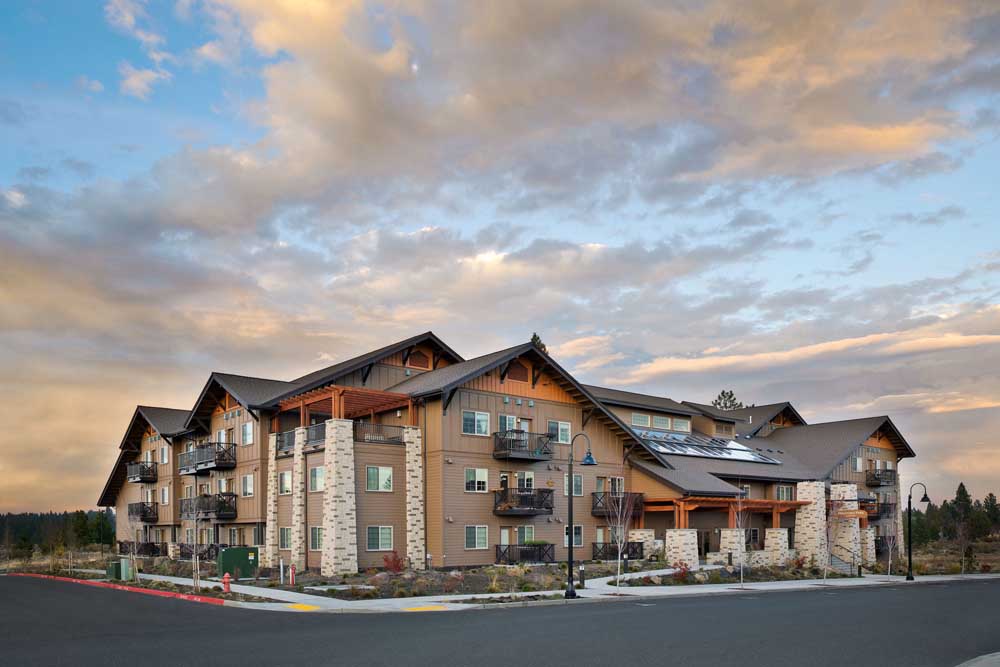Bend’s Affordable Housing Puzzle
Published 12:00 am Saturday, May 12, 2018

- Discovery Park Lodge, located in Northwest Crossing, is a 53-unit apartment building for low-income seniors. Utilizing many of tools available from the City of Bend, projects like Discovery Park Lodge are possible. The building’s amenities include three community rooms, a fitness room, internet stations and laundry facilities / submitted photo
Affordable housing is a topic with no shortage of definitions. HUD defines affordable housing as “housing for which the occupant(s) is/are paying no more than 30 percent of his or her income for gross housing costs, including utilities.” For a median income family in Bend, that means somewhere between $1,500 to $2,000 a month for rent or mortgage. A quick search for rentals on Craigslist shows around 70 properties available under $1,500. Still, 30 percent of income is quite a lot to pay for housing and does not leave much room for saving. With the median home price in Bend at $409,000 and 20 percent down payment, a mortgage payment including property taxes, insurance and possible homeowner’s association fees is close to $2,000 a month. What we are facing is more than an affordable housing crisis – it’s an attainable housing crisis. To address the breadth of the issue, Bend needs solutions across the housing spectrum.
Affordable Housing Solutions in Bend
We often hear that the City of Bend is a leader in Oregon on affordable housing. Given the number of our citizens still not able to afford housing, what does that mean? In general, the package the city has of funding and tools is much larger and more diverse than other areas. These tools are used for subsidized housing for individuals that make less than 80 percent of the area median income (AMI) when purchasing a home and those making less than 60 percent of AMI when looking for rentals, including:
● Bend utilizes federal funds from community block grants that have helped build 366 units since 2004.
● Bend’s affordable fee that comes as a portion of System Development Charges (SDC) has helped build 770 units since 2006.
● The city offers builders and developers SDC exemptions for building housing that is restricted to people making less than 80 percent of AMI.
● The city can donate surplus property it owns to affordable housing developers.
● The city can give tax exemptions from city property taxes.
● Density bonuses are available to projects with more than 50 percent of affordable units.
● Multifamily developments with units for those making 60 percent of AMI or less can opt for reduced parking requirements, one space per unit instead of one and a half.
Attainable Housing Solutions in Bend
While government can look at a variety of options to help subsidize housing for lower incomes, the role in market rate housing is far different. Last year the Central Oregon Association of REALTORS® and Bend2030 convened a housing workgroup to look at options for public-private partnerships to encourage inventory that those making up to 120 percent of AMI can afford. The group made 12 recommendations, many of which have made their way to the planning commission and city council. Along with Bend’s current cottage code and Accessory Dwelling Unit (ADU) policies, there are an increasing number of tools available that have the potential to open up options for the middle market centered around reducing costs, diversifying housing types and increasing inventory.
Diverse Housing Types
❍ The current Cottage Code provides an option for single family, detached homes under 1,000 square feet that utilize common space.
❍ ADUs are allowed and Bend recently removed the sidewalk requirement when building these units.
❍ The city is currently looking at changes on how fees are calculated for smaller units.
❍ The city is currently looking at how to allow fourplexes in the standard residential zone.
❍ Bend just created new urban renewal areas for the Bend Central District and Korpine sites.
Decreasing Costs
❍ The city council is moving forward to align the comprehensive plan and zoning map.
❍ Earlier this year the city reduced multifamily open space requirements for projects a quarter mile from a park.
Increasing Inventory
❍ Reducing parking requirements or allowing parking districts are not popular ideas in Bend, but can increase the number of units a project develops.
❍ The city council is prioritizing work on Empire Avenue and Murphy Road, which will open up hundreds of new home sites.
❍ Recently the areas of the Urban Growth Boundary (UGB) known as the Elbow and the Bend Central District/Korpine were identified as the first priorities for implementing the UGB.
Ways consumers can prepare for a tight housing market
● Build great credit.
● Save for a down payment.
● Look at starter homes to build equity.
● Utilize Oregon’s new first time home buyers savings account.
● Work with a lender that can present a variety of financial options.
● Work with a Realtor knowledgeable about the area and housing options.
Affordable and attainable housing is a puzzle. Diverse housing options, bringing down costs, good jobs and flexibility in a home search are the first pieces.








